what did darwin note about the islands animals regarding their reaction to human intruders
Most educated people in Europe and the Americas during the 19th century had their outset full exposure to the concept of development through the writings of Charles Darwin ![]() . Clearly, he did not invent the idea. That happened long before he was born. Nevertheless, he carried out the necessary research to conclusively certificate that evolution has occurred and then made the idea adequate for scientists and the general public. This was not easy since the idea of evolution had been strongly associated with radical scientific and political views coming out of post-revolutionary France. These ideas were widely considered to be a threat to the established social and political gild.
. Clearly, he did not invent the idea. That happened long before he was born. Nevertheless, he carried out the necessary research to conclusively certificate that evolution has occurred and then made the idea adequate for scientists and the general public. This was not easy since the idea of evolution had been strongly associated with radical scientific and political views coming out of post-revolutionary France. These ideas were widely considered to be a threat to the established social and political gild.
 | |
| Charles Darwin at age 7 |
Charles Darwin was born into a moderately wealthy family in Shrewsbury, England. His father, Robert, had the largest medical practice exterior of London at the time and his mother, Susannah Wedgwood, was from a family of wealthy pottery manufacturers. She died when Charles was only 8 years former. Thereafter, he was raised mostly by his father and doting older sisters. Charles grew up in comparative luxury in a large business firm with servants. Yet, this was a socially conservative fourth dimension in England that set narrow limits on a immature man's behavior and future possibilities. The constraints on women in Darwin'due south social class were even greater. Most were given only enough pedagogy to efficiently manage the homes of their hereafter husbands and raise their children. Young men were expected to go to university in gild to prepare themselves to become medical doctors, war machine officers, or clerics in the Church building of England. Most other occupations were considered somewhat unsavory.
At his father's direction, Charles Darwin started academy at sixteen in Edinburgh, Scotland every bit a medical educatee. He showed footling academic interest in medicine and was revolted by the brutality of surgery being performed without pain relief. Anesthesia was non used for operations until 1842. Darwin dropped out of medical school after two years of study in 1827. Nonetheless, his knowledge of natural history was incidentally enriched in Edinburgh by the teaching of Robert Grant, a noted professor of anatomy and an avid marine biologist. At Grant'south proposition, Darwin likewise became a member of Plinian Order for educatee naturalists at the University of Edinburgh.
Having given up on a medicine as a future career, Charles Darwin'south father so sent him to Cambridge University in 1828 to pursue an ordinary degree program with the goal of later becoming an Anglican parson. In Cambridge his life's direction continued its radical change. He became very interested in the scientific ideas of the geologist Adam Sedgwick and the naturalist John Henslow with whom he spent considerable fourth dimension collecting specimens from the countryside around the university. At this time in his life, Darwin apparently rejected the concept of biological evolution, just as his mentors Sedgwick and Henslow did. However, Darwin had been exposed to the ideas of Lamarck virtually evolution before while he was a student in Edinburgh.
| | |
| Charles Darwin |
 | |
| Captain Robert Fitzroy |
Following graduation from Cambridge in 1831 with a Bachelor of Arts caste, Darwin was clearly more interested in biology and geology than he was in a clerical career. Fortunately, John Henslow was able to help him secure a berth on a British Navy mapping trek that was going effectually the earth on what would ultimately become a nearly five year long voyage. Initially, Darwin's father refused to allow him to get but was eventually persuaded by Charles and even agreed to pay for his passage and for that of his man retainer on the journey. They sailed two days afterward Christmas in 1831 aboard the survey ship H.M.S. Beagle with Darwin acting as an unpaid naturalist and gentleman companion for the aristocratic captain, Robert Fitzroy. Darwin was 22 years old at the time, and Fitzroy was simply 4 years older. The Beagle was a compact 90 foot long send with a coiffure of 74. There was little space, even for the captain. Darwin shared a cramped ten 10 eleven foot motel with two other men, a cabin boy, and their belongings. Considering of the Beagle'southward design and small size, information technology was generally thought past naval men that it was ill suited for the rough seas it would see, especially at the southern tip of South America. Darwin frequently suffered from sea sickness on the voyage. Fortunately, he was able to spend nearly of the time on land exploring. In fact, he was at sea for only 18 months during the nearly 5 years of the trek.
Helm Fitzroy was interested in advancing science and was especially fatigued to geology. He had a surprisingly good library of over 400 books onboard the Beagle that he fabricated bachelor to Darwin. It was during the beginning of the voyage that Darwin read the showtime volumes of Charles Lyell's "Principles of Geology" and became convinced past his proof that uniformitarianism provided the right agreement of the world's geological history. This intellectual training, along with his research on the voyage, was critical in leading Darwin to subsequently take development. Especially important was his v weeks long visit to the Gal�pagos Islands ![]() in the Eastern Pacific Ocean. It was there that he made the observations that eventually led him to encompass what causes plants and animals to evolve, but he apparently did not clearly formulate his views on this until 1837. At the fourth dimension he left the Gal�pagos Islands, he apparently still believed in a traditional Biblical creation of all life forms.
in the Eastern Pacific Ocean. It was there that he made the observations that eventually led him to encompass what causes plants and animals to evolve, but he apparently did not clearly formulate his views on this until 1837. At the fourth dimension he left the Gal�pagos Islands, he apparently still believed in a traditional Biblical creation of all life forms.
The Gal�pagos Islands have species found in no other role of the earth, though similar ones exist on the westward declension of South America. Darwin was struck past the fact that the birds were slightly dissimilar from one island to some other. He realized that the cardinal to why this difference existed was connected with the fact that the diverse species alive in different kinds of environments.

On returning to England, Darwin and an ornithologist associate identified 13 species of finches that he had collected on the Gal�pagos Islands. This was puzzling since he knew of simply one species of this bird on the mainland of South America, nearly 600 miles to the east, where they had all presumably originated. He observed that the Gal�pagos species differed from each other in nib size and shape. He also noted that the beak varieties were associated with diets based on dissimilar foods. He concluded that when the original South American finches reached the islands, they dispersed to different environments where they had to conform to unlike conditions. Over many generations, they changed anatomically in ways that allowed them to get enough nutrient and survive to reproduce. This observation was verified by intensive field research in the terminal quarter of the 20th century.
Today nosotros use the term adaptive radiations to refer to this sort of branching evolution in which different populations of a species become reproductively isolated from each other by adapting to dissimilar ecological niches ![]() and eventually become separate species.
and eventually become separate species.
Darwin came to understand that any population consists of individuals that are all slightly unlike from one another. Those individuals having a variation that gives them an advantage in staying live long enough to successfully reproduce are the ones that laissez passer on their traits more often to the adjacent generation. Subsequently, their traits get more than common and the population evolves. Darwin called this "descent with modification."
The Gal�pagos finches provide an splendid example of this process. Among the birds that ended up in arid environments, the ones with beaks ameliorate suited for eating cactus got more food. As a upshot, they were in better status to mate. Similarly, those with beak shapes that were improve suited to getting nectar from flowers or eating hard seeds in other environments were at an reward there. In a very existent sense, nature selected the all-time adapted varieties to survive and to reproduce. This procedure has come to be known as natural selection .
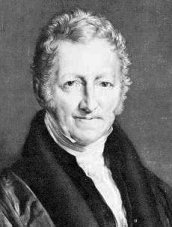 | |
| Thomas Malthus |
Darwin did not believe that the environment was producing the variation inside the finch populations. He correctly idea that the variation already existed and that nature just selected for the most suitable beak shape and against less useful ones. By the late 1860'south, Darwin came to draw this process equally the "survival of the fittest." This is very different from Lamarck'south wrong thought that the environment altered the shape of individuals and that these caused changes were and then inherited.
Nineteenth century critics of Darwin thought that he had misinterpreted the Gal�pagos finch information. They said that God had created the 13 unlike species as they are and that no evolution in nib shape has ever occurred. It was difficult to conclusively refute such counter arguments at that fourth dimension. However, extensive field inquiry since the early 1970's has proven Darwin to exist correct.
In 1798, Thomas Malthus ![]() , an English clergyman and pioneer economist, published Essay on the Principles of Population. In it he observed that human populations will double every 25 years unless they are kept in check by limits in food supply. In 1838, Darwin read Malthus' essay and came to realize that all plant and animal populations accept this aforementioned potential to speedily increase their numbers unless they are constantly kept in bank check past predators, diseases, and limitations in food, water, and other resources that are essential for survival. This fact was cardinal to his understanding of the process of natural pick. Darwin realized that the most fit individuals in a population are the ones that are least probable to die of starvation and, therefore, are most likely to pass on their traits to the next generation.
, an English clergyman and pioneer economist, published Essay on the Principles of Population. In it he observed that human populations will double every 25 years unless they are kept in check by limits in food supply. In 1838, Darwin read Malthus' essay and came to realize that all plant and animal populations accept this aforementioned potential to speedily increase their numbers unless they are constantly kept in bank check past predators, diseases, and limitations in food, water, and other resources that are essential for survival. This fact was cardinal to his understanding of the process of natural pick. Darwin realized that the most fit individuals in a population are the ones that are least probable to die of starvation and, therefore, are most likely to pass on their traits to the next generation.
![]() Who Was Charles Darwin?--video clip from PBS 2001 series Evolution
Who Was Charles Darwin?--video clip from PBS 2001 series Evolution
requires RealPlayer to view (length = half-dozen mins, 26 secs)
An instance of evolution resulting from natural selection was discovered amongst "peppered" moths living well-nigh English industrial cities. These insects take varieties that vary in wing and body coloration from light to dark. During the 19th century, sooty smoke from coal called-for furnaces killed the lichen on trees and darkened the bark. When moths landed on these trees and other blackened surfaces, the dark colored ones were harder to spot by birds who ate them and, subsequently, they more oftentimes lived long enough to reproduce. Over generations, the environment continued to favor darker moths. Equally a event, they progressively became more mutual. By 1895, 98% of the moths in the vicinity of English language cities like Manchester were more often than not black. Since the 1950'south, air pollution controls take significantly reduced the amount of heavy particulate air pollutants reaching the trees, buildings, and other objects in the environment. As a effect, lichen has grown dorsum, making trees lighter in color. In add-on, once blackened buildings were cleaned making them lighter in colour. Now, natural selection favors lighter moth varieties so they have become the nigh common. This trend has been well documented by field studies undertaken between 1959 and 1995 by Sir Cyril Clarke from the Academy of Liverpool. The same pattern of moth wing color evolutionary change in response to increased and later on decreased air pollution has been carefully documented by other researchers for the countryside around Detroit, Michigan. While information technology is abundantly clear that there has been an evolution in peppered moth coloration due to the advantage of cover-up over the concluding 2 centuries, i t is important to keep in heed that this story of natural choice in action is incomplete. There may have been boosted natural selection factors involved.
| Dark moths on light colored bark are |
Darwin'south use of the phrase "survival of the fittest" is frequently misunderstood. Many people assume that "the fittest" refers to the strongest, biggest, or smartest and most cunning individuals. This may or may not exist the example. From an evolutionary perspective, the fittest individuals are but the ones who have the combination of traits that allow them to survive and produce more offspring that in turn survive to reproduce. In fact, they may be relatively weak, small, and not especially intelligent. What makes an individual fit all depends on the surroundings at the time and the combination of traits that are most suited to flourishing in it. In the case of Darwin's finches, specialized beaks provided the advantage. However, in a changing environment, it is frequently the versatile generalist who has the greatest success.
Darwin did not believe that development follows a predetermined direction or that information technology has an inevitable goal. His explanation that evolution occurs equally a result of natural selection implied that chance plays a major role. He understood that it is a matter of luck whether any individuals in a population take variations that will allow them to survive and reproduce. If no such variations be, the population chop-chop goes extinct because it cannot adapt to a changing environment. Unlike Lamarck, Darwin did not believe that development inevitably produces more than complex life forms and that the ultimate result of this process is humans. These were shocking, revolutionary ideas fifty-fifty for scientists who accepted evolution.
Darwin did non rush his ideas well-nigh evolution and natural selection into print. He starting time concentrated his efforts on writing the account of his around the earth voyage on the Beagle and analyzing the many preserved brute and constitute specimens and extensive notes that he brought back with him. This occupied him for more than than 10 years. An boosted gene that may take held him back from publishing his ideas about evolution was the widespread Christian evangelical fervor in England during the 1830's and 1840's. He could have been charged with sedition and irreverence for widely publishing his unpopular theory.
Afterward returning from the voyage of the Beagle, Darwin settled down in England, married Emma Wedgwood (his wealthy first cousin), raised a large family, and quietly continued his enquiry at his newly purchased country home sixteen miles south of London. In 1842 he wrote a 35 page summary of his theory about evolution. This was expanded to a 230 page manuscript in 1844, but it was non published and apparently was only known to a few people in British scientific circles. Darwin busied himself over the next ii decades establishing his reputation as an important naturalist past growing and studying orchids, pigeons, earthworms, and other organisms at his home. He spent 8 of these years studying and writing about barnacles that people had sent him from around the earth.
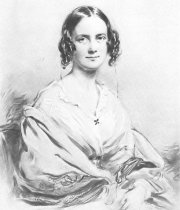 | 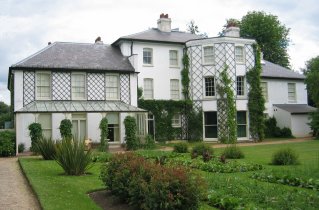 | 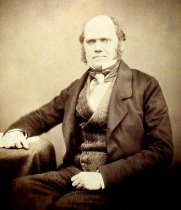 | ||
| Emma Darwin | Down House--Charles and Emma Darwin's state dwelling house where he wrote his major publications and their family lived contentedly for 40 years. | Charles Darwin |
It was not until he was l years former, in 1859, that Darwin finally published his theory of development in total for his fellow scientists and for the public at large. He did so in a 490 page book entitled On the Origin of Species. It was very popular and controversial from the offset. The first edition came out on November 24, 1859 and sold out on that 24-hour interval. It went through six editions by 1872. The ideas presented in this book were expanded with examples in 15 additional scientific books that Darwin published over the next two decades.
 | |
| Alfred Wallace 1823-1913 |
What finally convinced Darwin that he should publish his theory in a volume for the full general educated public was the draft of an essay that he received in the summer of 1858 from a younger British naturalist named Alfred Wallace ![]() , who was then hard at work collecting biological specimens in Southeast Asia for sale to museums and individual collectors. Darwin was surprised to read that Wallace had come upon essentially the same explanation for development. Beingness a off-white man, Darwin insisted that Wallace also go credit for the natural selection theory during debates over its validity that occurred at a meeting of the British Association for the Advocacy of Science at Oxford University in 1860. Nosotros at present know that Darwin deserves well-nigh of the credit. In 1837, one year after he returned from the voyage on the Beagle, he made detailed notes on the idea of development by means of natural option. At that time, Wallace was only 14 years sometime. In add-on, it was Darwin'southward book, rather than Wallace's essay, that had the about touch on on the Victorian public. Darwin non only described the process of natural selection in more detail, simply he also gave numerous examples of information technology. It was his On the Origin of Species that convinced most scientists and other educated people in the late 19th century that life forms exercise alter through fourth dimension. This prepared the public for the credence of earlier man species and of a world much older than 6000 years.
, who was then hard at work collecting biological specimens in Southeast Asia for sale to museums and individual collectors. Darwin was surprised to read that Wallace had come upon essentially the same explanation for development. Beingness a off-white man, Darwin insisted that Wallace also go credit for the natural selection theory during debates over its validity that occurred at a meeting of the British Association for the Advocacy of Science at Oxford University in 1860. Nosotros at present know that Darwin deserves well-nigh of the credit. In 1837, one year after he returned from the voyage on the Beagle, he made detailed notes on the idea of development by means of natural option. At that time, Wallace was only 14 years sometime. In add-on, it was Darwin'southward book, rather than Wallace's essay, that had the about touch on on the Victorian public. Darwin non only described the process of natural selection in more detail, simply he also gave numerous examples of information technology. It was his On the Origin of Species that convinced most scientists and other educated people in the late 19th century that life forms exercise alter through fourth dimension. This prepared the public for the credence of earlier man species and of a world much older than 6000 years.
![]() Darwin and Victorian Culture--interview with Darwin's biographer, James Moore
Darwin and Victorian Culture--interview with Darwin's biographer, James Moore
This link takes y'all to an audio file at an external website. To return hither, yous must click
the "dorsum" button on your browser programme. (length = eight mins, 5 secs)
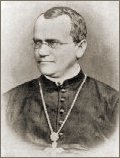 | |
| Gregor Mendel 1822-1884 |
Both Darwin and Wallace failed to understand an of import aspect of natural option. They realized that plant and beast populations are composed of individuals that vary from each other in physical form. They also understood that nature selects from the existing varieties those traits that are most suited to their environment. If natural choice were the simply process occurring, each generation should have less variation until all members of a population are essentially identical, or clones of each other. That does not happen. Each new generation has new variations. Darwin was aware of this fact, but he did not understand what caused the variation. The first person to begin to grasp why this happens was an obscure Primal European monk named Gregor Mendel ![]() . Through plant breeding experiments carried out between 1856 and 1863, he discovered that there is a recombination of parental traits in offspring. Sadly, Darwin and most other 19th century biologists never knew of Mendel and his inquiry. It was not until the beginning of the 20th century that Mendel'south pioneer research into genetic inheritance was rediscovered. This was long subsequently his death. He never received the public acclamation that was eventually showered on Darwin during his lifetime.
. Through plant breeding experiments carried out between 1856 and 1863, he discovered that there is a recombination of parental traits in offspring. Sadly, Darwin and most other 19th century biologists never knew of Mendel and his inquiry. It was not until the beginning of the 20th century that Mendel'south pioneer research into genetic inheritance was rediscovered. This was long subsequently his death. He never received the public acclamation that was eventually showered on Darwin during his lifetime.
Charles Darwin's convincing bear witness that development occurs was very threatening to many Christians who believed that people were created especially past God and that they have not changed biologically since that creation. The idea that in that location could take been prehistoric humans who were anatomically different from us was rejected for like reasons. Nonetheless, Charles Lyell's geological evidence that the earth must be much older than 6,000 years along with the rapidly accumulating fossil tape of by evolution convinced educated lay people in the 1860's to remember what had been unthinkable earlier.
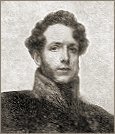 | |
| Boucher de Perthes 1788-1868 |
Archaeological confirmation of the being of prehistoric Europeans had been accumulating since the 1830'southward. Nevertheless, until the late 1850'south, information technology had been widely rejected or misinterpreted. Much of this show had been collected past Jacques Boucher Cr�vecoeur de Perthes ![]() , a customs officer in northern France during the early 1800'southward. His hobby was collecting aboriginal rock tools from deep down in the Somme River gravel deposits. Since he plant these artifacts in association with the bones of extinct animals, he ended that they must have been made at the time that those animals lived.
, a customs officer in northern France during the early 1800'southward. His hobby was collecting aboriginal rock tools from deep down in the Somme River gravel deposits. Since he plant these artifacts in association with the bones of extinct animals, he ended that they must have been made at the time that those animals lived.
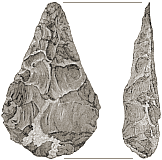 | |
| Prehistoric artifact incorrectly thought to be a "lightning bolt remnant" |
Boucher de Perthes tried to publish his findings in 1838. They were rejected by all important scientists and scientific journals. The prehistoric stone tools usually were dismissed as being but "lightning stones" (i.east., the remnants of lightning bolts). However, past 1858, his claims were first to be accustomed past some aware Western European scientists. Darwin's publication of On the Origin of Species the following year convinced even more than educated people that Boucher de Perthes had been right.
Darwin'southward popularizing the thought of evolution also made it possible for scientists to begin to take that some of the makers of Boucher de Perthes' prehistoric tools had already been discovered and that their bones were in museums. These basic had been institute in several Western European countries during the first half of the 19th century. However, they had all been dismissed as being from odd looking modern people. During the 1860's, some were correctly adamant to be from an earlier species or variety of people who had lived during the final ice age--i.e., long before recorded history. Nosotros now know that these ancient people were mostly Neandertals, who lived about 150,000-28,000 years ago.
NOTE : Charles Darwin was an active collector of plant and brute specimens and a prodigious note taker on the voyage of H.M.S. Beagle. By the fourth dimension the ship returned to England in 1836, he had accumulated five,436 plant and animal specimens that had been dried or preserved in alcohol. He had 368 pages of notes on plants and animals besides as one,383 pages of geological observations. In addition, he had a 770 page diary that was the basis for his later popular book of his narrative on the voyage ( " Journal of Researches Into the Natural History and Geology of the Countries Visited During the Voyage of H.M.Due south. Beagle Circular the World, Nether the Command of Capt. Fitz Roy, R.N. " ) .
Annotation : From the time that Charles Darwin published "On the Origin of Species" in 1859 on up to the present, the presumptions of many people led them to misread the title. They assumed that it was "On the Origin of the Species". The implication of inadvertently adding "the" is that his book was about human evolution. In fact, that was not the case, though it had implications for human evolution. Information technology focused on not-human animals and the mechanisms of evolution. He did not pointedly address the question of human being development until the publication of his 1871 book "Descent of Human being and Option in Relation to Sex".
Annotation : The phrase "survival of the fittest" was apparently commencement used in 1851 by the influential British philosopher Herbert Spencer (1820-1903) as a central tenet of what later on became known equally "Social Darwinism." He misapplied Darwin'southward idea of natural pick to justify European domination and colonization of much of the rest of the world. Social Darwinism was also widely used to defend the unequal distribution of wealth and ability in Europe and N America at the time. Poor and politically powerless people were thought to have been failures in the natural competition for survival. Subsequently, helping them was seen equally a waste product of fourth dimension and counter to nature. From this perspective, rich and powerful people did not demand to feel aback of their advantages because their success was proof that they were the most fit in this competition. Despite misgivings by Alfred Wallace and other naturalists, Charles Darwin began to use "survival of the fittest" equally a synonym for "natural pick" in the 5th edition of Origin of Species, which was published in 1869.
Note : H.Yard.Southward. Beagle, the famous send that took Charles Darwin on his 1831-1836 voyage around the world, had a rather mundane history following her return to England. She was transferred past the British Navy to the Customs and Excise Section and was used to catch smugglers along the southeast coast of England. The Beagle was finally sold for bit in 1870 afterward 50 years of service.
Copyright � 1998-2013 past Dennis O'Neil . All rights reserved.
illustration credits
Source: https://www2.palomar.edu/anthro/evolve/evolve_2.htm
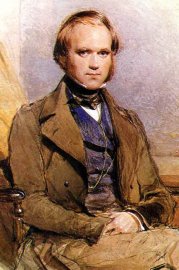
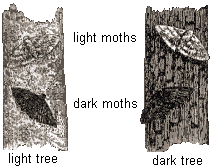
0 Response to "what did darwin note about the islands animals regarding their reaction to human intruders"
Postar um comentário